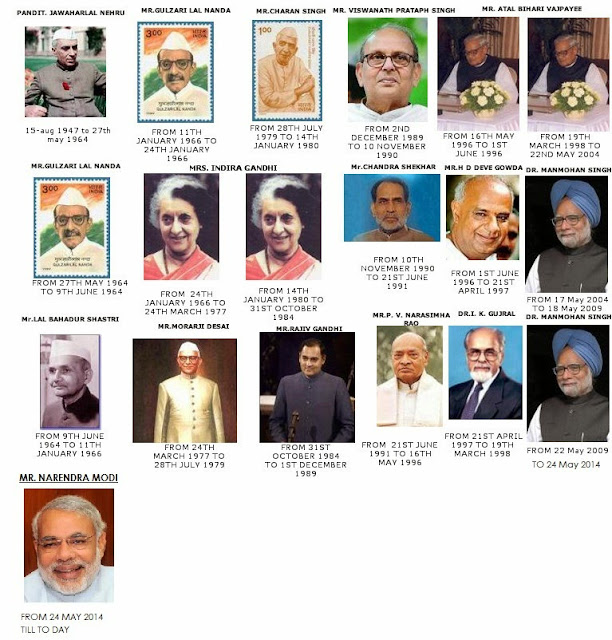Narendra Modi – 2014 till date
Manmohan Singh – 2004-14
Atal Bihari Vajpayee – 1998-2004
IK Gujral – 1997-98
HD Deve Gowda – 1996-97
AB Vajpayee – 1996
PV Narasimha Rao – 1991-96
Chandra Shekhar – 1990-91
VP Singh – 1989-90
Rajiv Gandhi – 1984-89
Indira Gandhi – 1980-84
Charan Singh – 1979-80
Morarji Desai – 1977-79
Indira Gandhi – 1966-77
Gulzarilal Nanda – 1966-66
Lal Bahadur Shastri – 1964-66
Gulzarilal Nanda – 1964
Jawaharlal Nehru – 1947-64
The details of their tenure since independence:
INDIAN NATIONAL CONGRESS
Jawaharlal Nehru
Tenure – 15th Aug 1947 – 27th May 1964 for 16 years, 286 days
Jawaharlal Nehru is the first Prime Minister of independent India and played a significant role in shaping modern India by imparting modern values and thinking. He was a social reformer and one of his major work towards society was the reform of the ancient Hindu civil code. It permitted Hindu widow to enjoy equal right with men as far as property and inheritance was concerned.
Gulzarilal Nanda
Tenure – 27 May 1964 – 9th June 1964 for 13 days
Tenure – 11th January 1966 – 24th January 1966 for 13 days
He was the first ‘Interim Prime Minister’ of India.
Lal Bahadur Shastri
Tenure – 9th June 1964 – 11 January 1966 for 1 year, 216 days
He was the loyal follower of Mahatma Gandhi and gave the popular slogan ‘Jai Jawan Jai Kisan’. Shastri was a soft-spoken person who promoted ‘White Revolution’ to increase the production of milk in India.
Indira Gandhi
Tenure – 24th January 1966 – 24th March 1977 for 11 years, 59 days
Tenure – 14th January 1980 – 31st October 1984 for 4 years, 291 days
Indira Gandhi was the first woman Prime Minister of India and the world’s longest serving woman Prime Minister. Her courage and boldness made India win over Pakistan in 1971. She made a significant contribution in improving international relations with neighbouring countries.
JANATA PARTY
Morarji Desai
Tenure – 24th March 1977 – 28th July 1979 for 2 years, 126 days
Morarji Desai is the first non Congress Prime Minister of India. He and his minister formally ended the state of emergency which was imposed by Indira Gandhi.
JANATA Party (SECULAR)
Charan Singh
Tenure – 28th July 1979 – 14th January 1980 for 170 days
As a Revenue Minister of Uttar Pradesh Charan Singh removed the Zamindari system and brought in Land Reform Acts.
INDIAN NATIONAL CONGRESS
Rajiv Gandhi
Tenure – 31st October 1984 – 2nd December 1989 for 5 years, 32 days
Rajiv Gandhi became Prime Minister at the age of 40 and played a major role in bringing computers to India. He actually modernized the Indian administration. He improved the bilateral relationships with the US and expanded economic cooperation.
JANATA DAL
V.P. Singh
Tenure – 2nd December 1989 – 10th November 1990 for 343 days
V.P. Singh worked to improve the condition of poor in the country.
SAMAJWADI JANATA PARTY
Chandra Shekhar
Tenure – 10th November 1990 to 21st June 1991 for 223 days
INDIAN NATIONAL CONGRESS
P. V. Narasimha Rao
Tenure – 21st June 1991 – 16th May 1996 for 4 years 330 days
P. V. Narasimha Rao was one of the most able administrators who brought major economic reforms. He is also known as the Father of Indian Economic Reforms. He dismantled the License Raj and reversed the socialist policies of Rajiv Gandhi’s government. Because of his immense ability he was also referred to as Chanakya.
BHARATIYA JANATA PARTY
Atal Bihari Vajpayee
Tenure – 16th May 1996 – 1st June 1996 for 16 days
Tenure –19th March 1998 – 22nd May 2004 for 6 years 64 days
Atal Bihari Vajpayee was one of the finest Prime Ministers of India. During his tenure the inflation was very low in India. He worked on economic reforms and policies especially for rural India. It was during his tenure that India Pakistan relationship got slightly better. Telecom industry touched new heights.
JANATA DAL
H. D. Deve Gowda
Tenure – 1st June 1996 – 21st April 1997 for 324 days
During this period, Deve Gowda also held additional charges of Home Affairs, Petroleum and Chemicals, Urban Employment, Food processing, Personnel, etc. He had been collectively elected leader of the United Front coalition government.
I.K. Gujral
Tenure- 21st April 1997 – 19th March 1998 for 332 days
The most important task during his term as PM was his resistance in signing CTBT(Comprehensive Test Ban Treaty). It made a clear way to conduct the Pokhran nuclear tests. He worked towards improving relationship with Pakistan and gave a five-point doctrine known as Gujral Doctrine.
INDIAN NATIONAL CONGRESS
Manmohan Singh
Tenure – 22nd May 2004 – May 2014
During the tenure of Manmohan Singh work was done to reform the banking as well as financial sector along with public companies. His government brought in the value added tax and worked on pro-industry policies. The National Rural Health Mission was started in 2005. Eight additional IITs were opened in Andhra Pradesh, Bihar, Gujarat, Orissa, Punjab, Madhya Pradesh, Rajasthan and Himachal Pradesh.
BHARATIYA JANATA PARTY
Narendra Modi
Tenure – May 2014- Narendra Damodardas Modi assumed office on May 26, 2014. He is the 15th Prime Minister of India. Since the beginning of his tenure in 2014, Modi has laid down a strict and disciplined system of governance. He has enforced many policies such as the Jan Dhan Yojana, Swachh Bharat Abhiyan – aimed towards cleanliness marking the 150th birth anniversary of Mahatma Gandhi in 5 years, Clean Ganga project, etc. for the upliftment of the nation.

No comments:
Post a Comment